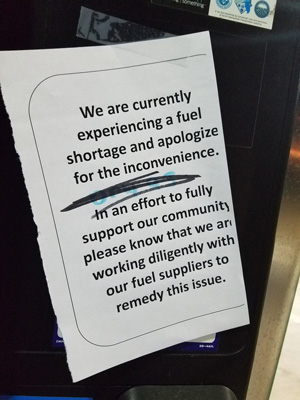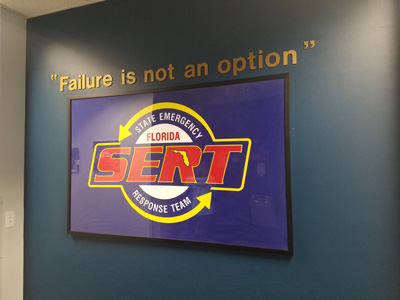By Frank Beard
As expected, the flight to Tallahassee was nearly empty.
It was Friday, September 7, and all eyes were on Florida as Hurricane Irma neared landfall. Although projections initially showed the storm moving up the East Coast, the sheer size of Irma—and changing nature of the forecasts—meant that I had arrived in a potentially dangerous situation.
I wasn’t worried, but what did I know? I’m a midwestern guy whose only experience with severe weather is an occasional tornado or blizzard.
 To put Irma in perspective, imagine a storm more than 400 miles wide—larger than most states—that can produce wind speeds as intense as an EF3 and EF4 tornado across a 70-mile radius. Rather than lasting hours, it lasts days—moving across the state at the pace of a bicycle ride while producing sustained rain, flooding, and even occasional tornadoes.
To put Irma in perspective, imagine a storm more than 400 miles wide—larger than most states—that can produce wind speeds as intense as an EF3 and EF4 tornado across a 70-mile radius. Rather than lasting hours, it lasts days—moving across the state at the pace of a bicycle ride while producing sustained rain, flooding, and even occasional tornadoes.
It’s the kind of situation that causes panicked purchases at the pump as millions flee to safety. And with the refineries still feeling the effects of Hurricane Harvey, it was a recipe for severe shortages.
That’s why I was there along with my colleague Patrick DeHaan, GasBuddy’s senior petroleum analyst. While GasBuddy was used by numerous evacuees fleeing the storm—Gov. Rick Scott frequently mentioned the app in press conferences—we found that the app was in able to assist the state’s emergency response efforts by providing data on outages. The result was five days on the ground at the Florida Division of Emergency Management.
It was an experience I won’t soon forget. We slept on cots; spent a night on the floor of Florida A&M’s basketball arena, awoken at 2:00am by the sound of hurricane alerts on hundreds of phones; spoke with evacuees; located fuel for teams in the field; and saw firsthand how Florida responds to disasters.
I even managed to learn a few lessons along the way.
(1) Crowdsourcing can save lives.
We take for granted the convenience of having quick and easy access to fuel, but what if the pumps suddenly ran dry? What if you had to make the approximately 650-mile drive from Miami to Atlanta in the midst of severe shortages, with a hurricane nipping at your heels?
Suddenly a routine activity becomes a dangerous situation.
By activating our emergency fuel tracker, GasBuddy could provide a platform to report which stations had gas, diesel and power. While crowdsourcing is the app’s lifeblood, GasBuddy Business Pages partners were also able to directly submit data on their stores, and we opened it up for free to those who weren’t already working with us. The result was a wealth of information that gave motorists one less problem to worry about.
Crowdsourcing gives everyone a way to help. And those collective efforts enabled me to assist various officials with difficult situations.
One day, a group of responders was moving elderly individuals from a retirement home and had nearly run out of gas near Tampa. Within minutes, I could locate a store approximately 20 miles north of their location that reported to have fuel. After a quick phone call to verify, I sent them on their way—confident that they’d be able to purchase a full tank.
(2) Failure is not an option.
It’s a phrase that was posted prominently on the wall at the command center, but it came to define our experience.
It’s fun to talk about convenience store trends, ratings and reviews, and gas prices, but this experience reminded me how vitally important the work is that all of us do. The refiners, the drivers, the person who answers the phone and says, “Yes, we have gas!”—it’s all part of one vital process.
Without diesel, emergency crews couldn’t provide disaster relief. Without fuel, people couldn’t evacuate or return home. When officials approached us for specific data or asked for help locating fuel in the field, failure to deliver meant real consequences for real people.
 (3) Convenience stores are community stores.
(3) Convenience stores are community stores.
Many of the local convenience stores were the last businesses to close and the first to reopen. They functioned as local hubs—with people gathering late at night to talk about the storm, grab a snack when restaurants were closed, or stock up on essentials. These stores provided a vital function to local residents. As NACS Chairman Rahim Budhwani said during the closing session of the 2016 NACS Show, “C-store does not stand for convenience store, it stands for community store.”
(4) We get more done when we work together.
Natural disasters aren’t the time for political squabbles, personal issues and other conflicts that typically divide us. They’re a time to come together and work towards a common goal, to press pause and put those matters aside for later.
I came away from this experience with a renewed sense of optimism. Not only was I impressed with the intensity and dedication of officials like Gov. Scott and Lieutenant Gov. Carlos López-Cantera, but everyone at every level—state, federal and private—who was singularly-focused on working together to help Florida recover. All that mattered is that you were there to help.
Frank Beard is a regular NACS Daily contributor who has traveled to more than 1,000 convenience stores in 24 states. He raised awareness of the industry's healthful food options with his "30 Days of Gas Station Food" experiment, and he's an analyst/evangelist for convenience store and retail trends at GasBuddy. Follow Frank on Twitter here.